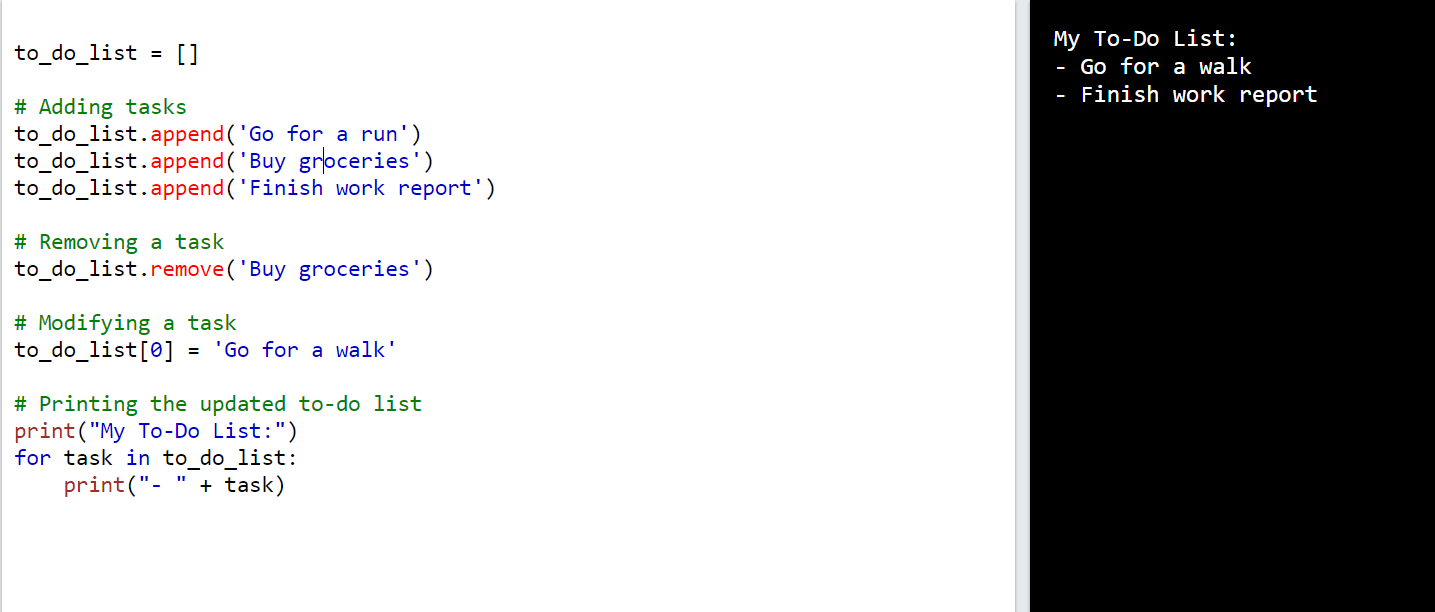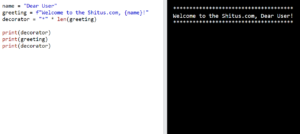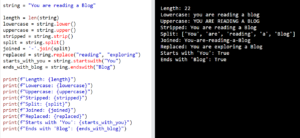Python lists are essential data structures in Python. They allow you to store multiple items in a single variable and perform various operations on those items.
In this blog post, we will cover everything you need to know about Python lists.
What are Python lists?
Python lists are a fundamental data structure in Python that allows you to store and organize multiple items in a single variable. They are used to hold a collection of elements, such as numbers, strings, or even other objects.
Lists are mutable, which means you can change their elements after they are created. This flexibility makes them powerful for manipulating and managing collections of data in Python.
How to create Python lists
Start by opening a pair of square brackets [], which is used to define a list in Python.
Inside the brackets, you can add elements separated by commas. These elements can be of any data type (e.g., numbers, strings, booleans) or even other objects.
Once you have added all the elements, close the brackets to complete the list.
Here’s an example of a simple list:
fruits = ['apple', 'banana', 'orange', 'grape'] #This is a simple list print(fruits)
Output
['apple', 'banana', 'orange', 'grape']In this example, the fruits list contains four elements: ‘apple’, ‘banana’, ‘orange’, and ‘grape’. Each element is assigned an index, starting from 0 for the first element, 1 for the second element, and so on.
How to access elements in Python lists
To access elements in Python lists, you can use indexing. In Python, indexing starts at 0, which means the first element of a list is at index 0, the second element is at index 1, and so on.
Example:
# Define a list
my_list = ['apple', 'banana', 'orange', 'grape']
# Access individual elements
first_element = my_list[0] # Access the first element (index 0)
second_element = my_list[1] # Access the second element (index 1)
third_element = my_list[-1] # Access the last element using negative indexing
sliced_elements = my_list[1:4] # Access a range of elements (index 1 to 3)
# Print the elements
print(first_element)
print(second_element)
print(third_element)
print(sliced_elements)
Output:
apple
banana
grape
['banana', 'orange', 'grape']Python List Methods
| Function | Description |
|---|---|
len() | Returns the length of the list. |
append() | Adds an element to the end of the list. |
extend() | Extends a list by adding elements from another list. |
insert() | Inserts an element at a specific index in the list. |
remove() | Removes the first occurrence of a specific element from the list. |
pop() | Removes and returns the element at a specific index in the list. |
index() | Returns the index of the first occurrence of an element. |
count() | Returns the number of occurrences of an element in the list. |
sort() | Sorts the elements of the list in ascending order. |
reverse() | Reverses the order of the elements in the list. |
copy() | Returns a shallow copy of the list. |
clear() | Removes all elements from the list. |
max() | Returns the maximum element in the list. |
min() | Returns the minimum element in the list. |
sum() | Returns the sum of all elements in the list. |
sorted() | Returns a new list with elements sorted in ascending order. |
any() | Returns True if at least one element is True, else False. |
all() | Returns True if all elements are True, else False. |
enumerate() | Returns an enumerate object of index-element pairs from the list. |
zip() | Returns an iterator of tuples with corresponding elements. |
How to modify Python lists
Adding Elements
You can add elements in various ways. Here are the most used ways:
1. append(): Adds an element to the end of the list.
my_list = [1, 2, 3]
my_list.append(4) # Output : [1, 2, 3, 4]
2. extend(): Extends the list by adding elements from another list.
my_list = [1, 2, 3]
other_list = [4, 5, 6]
my_list.extend(other_list) #Output: [1, 2, 3, 4, 5, 6]
3. the + operator: Concatenates two lists.
my_list = [1, 2, 3]
other_list = [4, 5, 6]
combined_list = my_list + other_list # Output: [1, 2, 3, 4, 5, 6]
4. insert(): Inserts an element at a specific index in the list.
my_list = [1, 2, 3]
my_list.insert(1, 10) # Output: [1, 10, 2, 3]
Removing Elements
1. Using remove(): Removes the first occurrence of a specific element from the list.
my_list = [1, 2, 3, 2]
my_list.remove(2) # Output: [1, 3, 2]
2. Using pop(): Removes and returns the element at a specific index in the list.
my_list = [1, 2, 3]
element = my_list.pop(1) # element is 2, my_list is [1, 3]
print(my_list) #Output: [1, 3]3. Using the del statement: Removes an element or a slice of elements from the list.
my_list = [1, 2, 3, 4, 5]
del my_list[2] # [1, 2, 4, 5]
del my_list[1:3]
print(my_list) # Output: [1, 5]Modifying Elements
Accessing elements by index and assigning new values.
my_list = [1, 2, 3, 4, 5]
my_list[2] = 10 #Output: [1, 2, 10, 4, 5]
Slicing and assigning new values to a range of elements.
my_list = [1, 2, 3, 4, 5]
my_list[1:3] = [10, 20] # [1, 10, 20, 4, 5]
Example 1
In this unique example, we start with a list [‘dog’, ‘cat’, ‘cow’] and demonstrate various modification operations. We add elements using append(), extend(), and insert(). Then, we remove elements using remove(), pop(), and del. Finally, we modify elements by directly assigning new values using indexing and slicing.
After applying these modifications, the final list is [‘elephant’, ‘lion’, ‘tiger’]. This example showcases how you can modify a list by adding, removing, and modifying elements to suit your needs.
my_list = ['dog', 'cat', 'cow']
# Adding elements
my_list.append('fish') # ['dog', 'cat', 'cow', 'fish']
other_list = ['hamster', 'rabbit']
my_list.extend(other_list) # ['dog', 'cat', 'cow', 'fish', 'hamster', 'rabbit']
my_list.insert(1, 'turtle') # ['dog', 'turtle', 'cat', 'cow', 'fish', 'hamster', 'rabbit']
# Removing elements
my_list.remove('cow') # ['dog', 'turtle', 'cat', 'fish', 'hamster', 'rabbit']
element = my_list.pop(3) # element is 'fish', my_list is ['dog', 'turtle', 'cat', 'hamster', 'rabbit']
del my_list[0] # ['turtle', 'cat', 'hamster', 'rabbit']
del my_list[1:3] # ['turtle', 'rabbit']
# Modifying elements
my_list[0] = 'elephant' # ['elephant', 'rabbit']
my_list[1:3] = ['lion', 'tiger'] # ['elephant', 'lion', 'tiger']
print(my_list) # Output: ['elephant', 'lion', 'tiger']
Example 2
In this example, we simulate a to-do list. Initially, the to_do_list is empty. We add tasks using append(), remove a task using remove(), and modify a task by assigning a new value directly using indexing.
After the modifications, we print the updated to-do list using a simple loop, where each task is preceded by a hyphen (“-“) for a clear representation.
to_do_list = []
# Adding tasks
to_do_list.append('Go for a run')
to_do_list.append('Buy groceries')
to_do_list.append('Finish work report')
# Removing a task
to_do_list.remove('Buy groceries')
# Modifying a task
to_do_list[0] = 'Go for a walk'
# Printing the updated to-do list
print("My To-Do List:")
for task in to_do_list:
print("- " + task)
Output:
My To-Do List:
- Go for a walk
- Finish work report






4 thoughts on “Python Lists: Everything You Need to Know”